The Intel Core Ultra 7 155H Review: Meteor Lake Marks A Fresh Start To Mobile CPUs
by Gavin Bonshor on April 11, 2024 8:30 AM ESTASUS Zenbook 14 OLED UX3405MA: Power, System & Storage Performance
As we did in our review of the Razer Blade 14 (2023) gaming notebook, we're also including a pair of desktop chips in our comparison. This includes the AMD Ryzen 7 8700G and Ryzen 5 8600G, which are APUs and are actually based on AMD's Phoenix mobile architecture. This relates to our testing of the AMD Ryzen 9 7940HS, which includes the same Radeon 780M integrated graphics. However, the Ryzen 8000G APUs are adopted for desktops. This allows us to show more data points for our review of Intel's Meteor Lake-based Core Ultra 7 155H to see where performance lies.
Despite including AMD's Phoenix-based Ryzen 8000G APUs in our results, as we expand our list of notebooks tested, we'll have more effective and comparable data points in the future. To add more reference, all of the chips have been tested with Windows 11 22H2.
Power
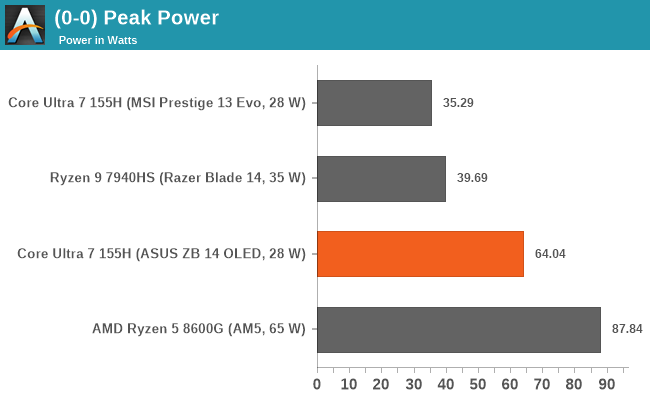
We can see that the peak power value on the Intel Core Ultra 7 155H-equipped ASUS laptop hits just below 65 W, which is Intel's minimum assured power (MAP) value for this specific chip. Although the Intel Core Ultra 7 155H has a maximum turbo TDP of 115 W, which is entirely dependent on the mobile manufacturer to implement, and such is the case of the ASUS Zenbook 14 OLED UX3405MA ultrabook, it is too thin and light on cooling to be able to cater to such high power draw. For the purposes of this review, we've limited the Ryzen 9 7940HS to its base TDP of 35 W, which means there will be some variance depending on the workload, which can range up to 39 W.
We can see something very interesting by looking more in-depth at the Intel Core Ultra 7 155H power within the ASUS Zenbook 14 OLED. Using the latest CineBench 2024 rendering benchmark on a loop with the multi-threaded test selected, we can see that the Core Ultra 7 155H hits thermal and power throttling very quickly. Within five seconds of the start of the benchmark, the Core Ultra 7 155H peaks around 64-65 W. It then quickly ramps down to between 28 and 30 W, which is around the base TDP of the chip, which Intel rates at 28 W. This means the chip is throttling by more than half of the 65 W maximum assured power rating Intel has given this chip.
Another thing we can see from our power testing is that the Ryzen 9 7940HS, at the default settings, operates at a higher power than the Core Ultra 7 155H over a prolonged period. To make performance comparisons fairer where we can, we put the Razer Blade 14 into silent mode, which reduced the power of the Ryzen 9 7940HS down to around 39 W for sustained load. This chip isn't overclockable, so there's no viable way to control power consumption.

Using the low power mode, which ASUS officially calls 'whisper mode' on the ASUS Zenbook 14 OLED, we can see this reduces power massively with a peak of 19 W before settling quickly to a consistent 14-15 W range. As we can see in the above Blender 3.6 data, the whisper mode and a lower power profile applied to the Core Ultra 7 155H prove ineffective regarding workload performance. The Ryzen 7940HS also exhibits similar behavior in multi-threaded workloads, peaking at 45 W before quickly settling down to a very consistent mark of around 38-39 W throughout the benchmark.
Ultimately, this helps to properly characterize the power characteristics of our sample laptops. While both the Intel and AMD chips have overlapping TDPs, the Razer Blade that the Ryzen chip sits in is very clearly built and tuned for higher sustained power than the thin-and-light ASUS ultrabook. So we never have an entirely apples-to-apples testing scenario, though short of putting both chips in the same chassis, that would always be the case. That being said, we have tried to limit the power on the Ryzen 9 7940HS to its base TDP of 35 W, just to make things a little more fairer.
As for the Zenbook in particular, this tells us that its cooling isn't enough to provide enough capability to sustain high power in multi-threaded workloads, at least not in line with Intel's 65 W value for maximum assured power. While it's true that different types of workloads are more intensive than others, and CineBench 2024 MT is considered a heavy test, we're effectively showing the worst-case scenario here for the Core Ultra 7 155H. That means that results may vary in different multi-threaded workloads and with different models of notebooks with different levels of cooling.
Looking at single-threaded power consumption in CineBench 2024, the Core Ultra 7 155H peaks at around 43 W before ramping down to a semi-consistent power range of between 27 and 30 W. The AMD Ryzen 9 7940HS is more power efficient than Intel's Meteor Lake architecture in single-threaded performance, with a quick ramp up to around 41 W and then an ultra-consistent value of between 23 and 24 W. How that translates into performance in our benchmark suite for 2024 shapes up to be a battle of Intel's Core Ultra 7 155H at a sustained 28 W, versus the AMD Ryzen 9 7940HS that we forced to run at base TDP (35 W) at around 29 W in single-threaded applications.
Web & Office
The next section of our updated notebook test suite is web and office-based tests. Our updated notebook suite runs in parallel with our current CPU test suite for 2023. It allows us to blend mobile chips tested with desktop chips, mainly to see efficiency and performance levels and how they stack up for each generation we try.
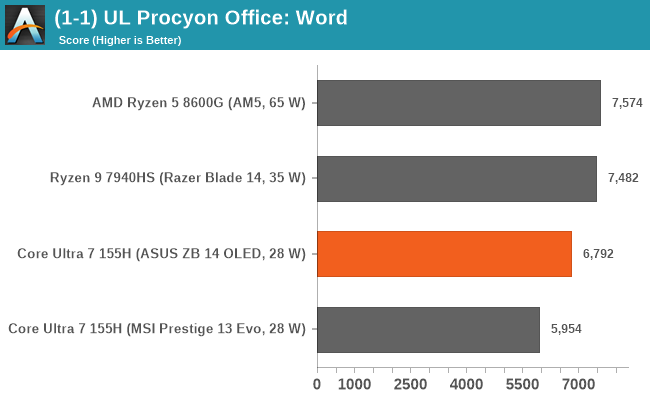
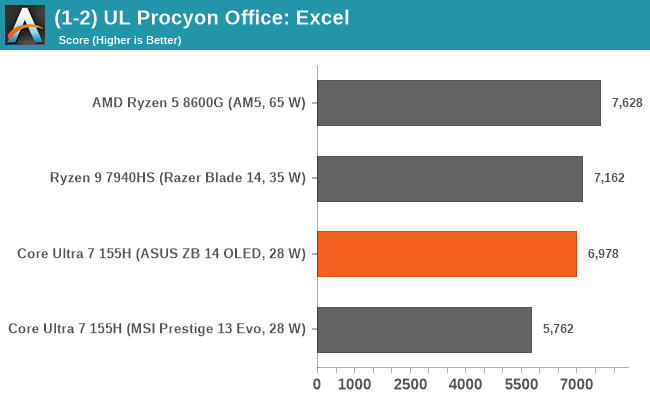
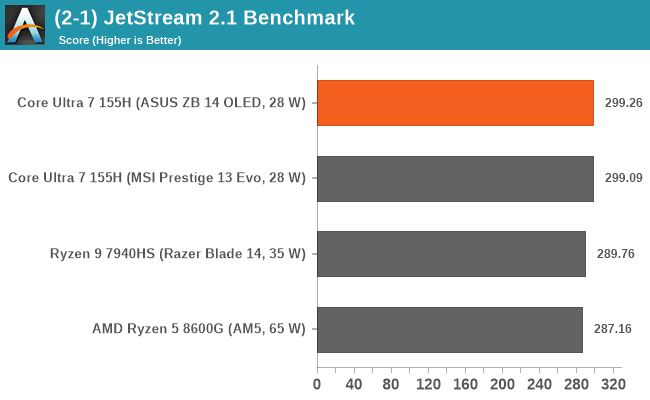
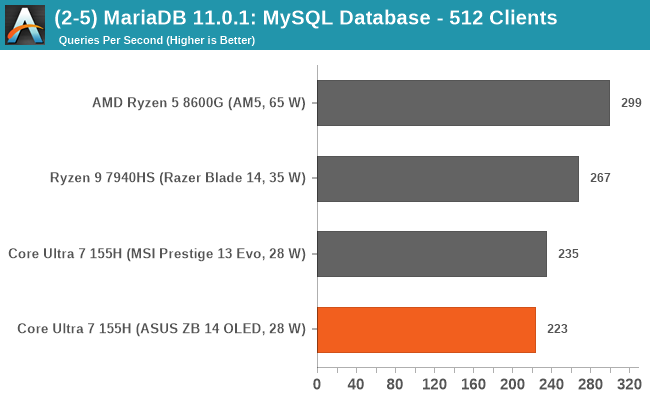
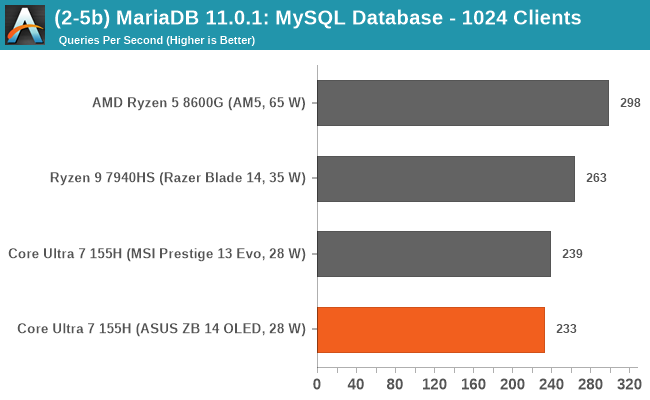
Looking at performance in our web and office-based testing, in the UL Procyon Office-based tests using Microsoft Office, the Core Ultra 7 155H is competitive but lags behind the AMD chips slightly. Meteor Lake does very well in the web-based Jetstream 2.1 benchmark, even outperforming the desktop-based Ryzen 8000G APU pairing. We see a different story in our MariaDB MySQL database benchmarks, although performance is still relatively competitive compared to the AMD chips we've tested.
Storage
Storage performance is dictated by more than just putting in the fastest drive you can; other variables include the interface used, the quality of the controller, and the overall drive. The ASUS Zenbook 14 OLED UX3405MA includes a 1 TB drive, which is labeled as a Western Digital WD560 NVMe drive. It has a PCIe 4.0 x2 interface, which means its performance is similar to that of a PCIe 3.0 x 4 M.2 drive.
Unfortunately, we couldn't find any official specifications for the Western Digital WD560 NVMe SSD. However, as we can see in CrystalDiskMark, we are seeing sequential read speeds of just under 5000 MB/s with sequential write performance of around 3300 MB/s. This is still good raw throughput performance for an ultrabook such as the ASUS Zenbook 14 UX3405MA, although this will differ between both compressed and uncompressed data.
When judging and measuring storage performance, it comes down to real-world performance and ensuring optimal cooling, especially on these fast NVMe drives, which can run very hot and thermally throttle, reducing performance.

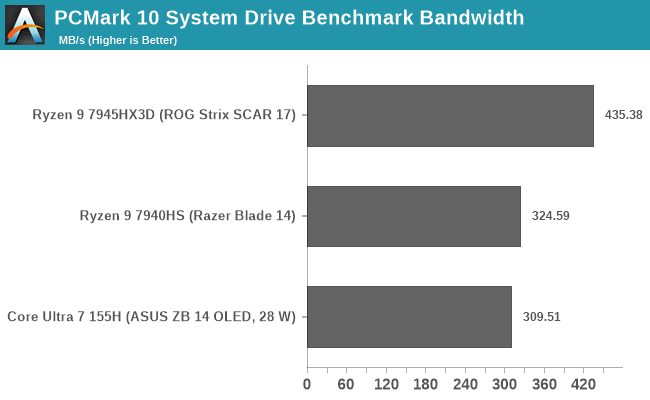
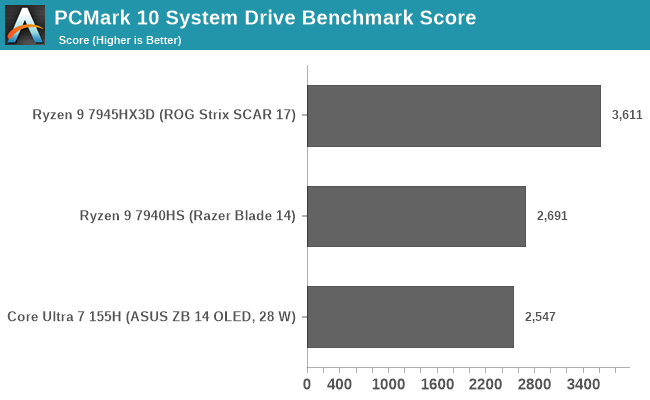
Using the storage benchmark built into PCMark 10, we can see that the ASUS Zenbook 14 UX3405 and the WD560 1 TB SSD being used are somewhat inferior to drives in other similar notebooks we've tested. For storage, we've included the ASUS ROG Strix SCAR 17, which is a desktop replacement model and ultimately has the best-in-class storage it can accommodate.
Even compared to the MSI Prestige 13 AI Evo A1MG notebook, which also has an Intel Meteor Lake Core Ultra 7 155H installed, the storage performance of the ASUS Zenbook 14 OLED isn't up to the same level.


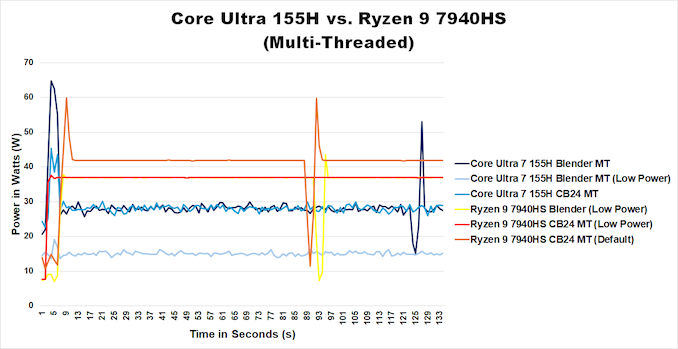
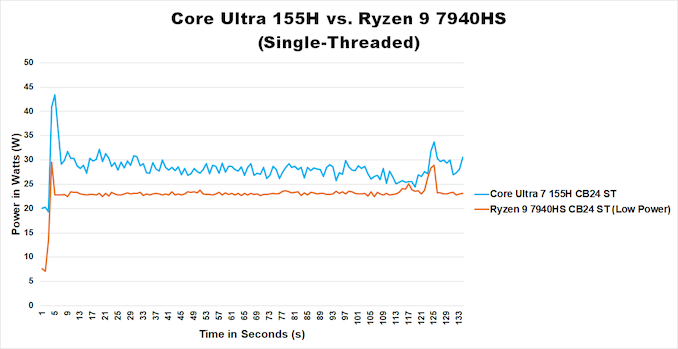









69 Comments
View All Comments
jeenam - Friday, April 12, 2024 - link
I've been an anandtech reader since 1998 or so and I'm not here to pick a bone. I'm a fan, and hope AT lives on. But did a quick search and the only two major websites with GPU reviews that referenced Returnal or Company of Heroes were Hot Hardware and Ars Technica. An expanded test suite of games might have been more appropriate because it's likely the ARC GPU would have been handily beaten across the board. Replysjkpublic@gmail.com - Thursday, April 11, 2024 - link
Strange. Some of the tests list the 155H as 28W with test results. This is misleading as the SoC uses much more power doing the test. ReplyGavin Bonshor - Friday, April 12, 2024 - link
When we review CPUs, especially when highlighting them in the charts, we list the base TDP, as every motherboard has its own interpretation of what level of power it will push through the chip (Multi-core enhancement). ReplyCarmen00 - Friday, April 12, 2024 - link
Yet in another comment, we have Ryan Smith saying "With these integrated devices, we're reviewing the notebook as much as we're reviewing the chip inside."So if you're doing what he says—post the right numbers, because that's what you're doing. And if you're NOT doing what he says, then don't post useless stuff that seems, to my (perhaps overly-critical eye) to exist so that the article can claim that Intel is scoring SOME kind of a win, when the graphs really don't seem to show a heck of a lot of CPU-related win.
I'm fine with either, let me be honest. But I want to see some consistency, that is all. Reply
Ryan Smith - Friday, April 12, 2024 - link
I'm all for trying to make sure you guys get the data that you want to see. But not sure I follow here. We are being consistent in our testing methodology, and taking care to be explicit in that our test systems don't have identical TDPs.https://images.anandtech.com/doci/21282/Core%20Ult...
In a laptop, sustained TDPs are our primary concern, as these devices cannot turbo multiple cores for more than a few seconds. So this is what we're noting in an article like this, to illustrate how we aren't testing devices with matching TDPs. Reply
ballsystemlord - Friday, April 12, 2024 - link
I agree with Ryan here, sustained performance is what you should be looking at. Anything can turbo to infinity.The only real use case for turbo, would be application start-up. But even then, you'd have to be waking the PC from idle and selecting the application in record time for it to matter at all. Reply
lmcd - Wednesday, April 17, 2024 - link
The problem I'm seeing is that this article takes the format of previous laptop reviews but not the depth (in part due to the declining access this publication), and the headline could better fit the contents. It could even be something silly like "The Intel Core Ultra 7 155H Review: Meteor Lake starts with a Moment of Zen(Book)" and be more valuable to the reader.It also did not feel like we really got (even a rehash of) an overview of Meteor Lake as a platform. So to me, this was an ASUS Zenbook review. Framing this as "ASUS ZenBook 14 OLED: A Meteor Lake Thin&Light Review" also better captures its content. Reply
eastcoast_pete - Friday, April 12, 2024 - link
I am not surprised that the Core 7 Meteor Lake isn't beating the Ryzen 7840HS in compute or graphics - that particular Ryzen 4 monolith is (IMHO) currently AMD's best foot forward, and a great APU. However, Intel did do its homework when it comes to the intended use of Meteor Lake SoCs: mobile, especially light and ultralight laptops and 2-in-1s. I don't expect a ~ 1 kg notebook to do that much higher level gaming or compute. I do expect long runtime on battery, fluid use of office and other productivity apps, and otherwise decent performance (speed). Again, AMD's Phoenix/Hawk APUs are, right now, the most performant solutions in that class, but it's good news for all of us that Intel has closed the gap. It'll mean that AMD will have to keep evolving its APUs, and maybe do a better job making them broadly available with good drivers within a few months of announcing them. Because that was not the case with Phoenix, which just took too long to be ready for prime time, and left the opening for Intel to move back into.Lastly, I find that one of the most remarkable things about Meteor Lake is that Intel got its tile design and packaging working quite well. Being able to combine different chips from different fabs (Intel and TSMC) and nodes into a cohesive unit without incurring large hits on performance and efficiency is big step forward. Reply
nandnandnand - Saturday, April 13, 2024 - link
Lunar Lake will be the one to watch. It's Meteor Lake-U evolved (4+4 instead of 2+8, on-package memory by default, decent graphics). Low power mobile chips are more interesting than the 45W+ ones. Replymode_13h - Monday, April 15, 2024 - link
> Being able to combine different chips from different fabs (Intel and TSMC)> and nodes into a cohesive unit without incurring large hits on performance
> and efficiency is big step forward.
AMD combined chiplets from both TSMC and Global Foundries in the same CPU, all the way back in Zen 2! If you count HBM, they combined chiplets from different foundries as far back as their HD Fury GPUs.
As for performance and efficiency, I find Meteor Lake underwhelming on both fronts. Idle performance and things like video playback gain a benefit from the new SoC architecture, but when it comes to compute-intensive tasks, we see why Intel kept around Raptor Lake for the performance-oriented segment. Reply